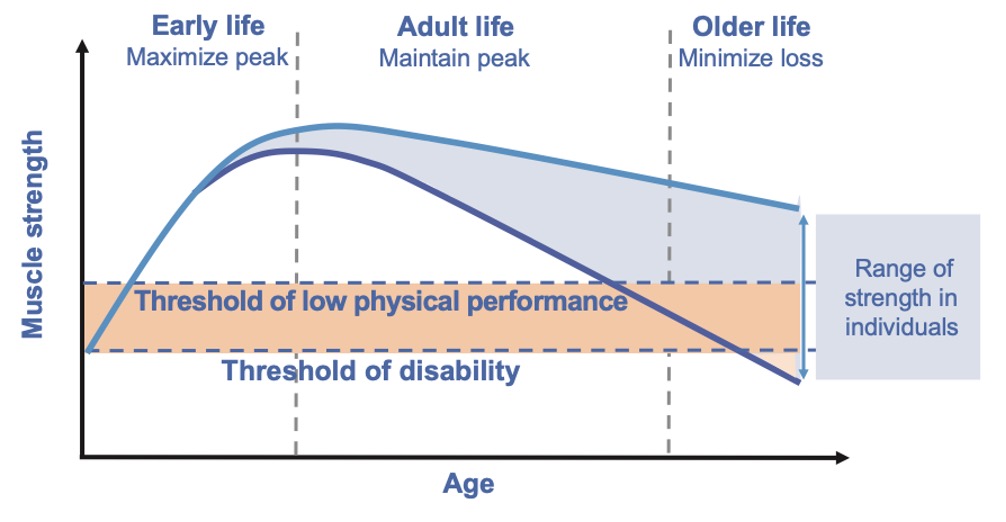Helping to Manage Age-related Conditions and Degenerative Changes
As we age, it’s normal to experience changes in strength, mobility, and balance. However, age-related change can be delayed, and one of the most effective ways to counteract it is through strength training.
In this article, we examine why resistance exercise is essential for older adults, particularly in managing conditions such as osteoarthritis (OA), osteoporosis, and degenerative changes.
What Can Change and Why it Matters
Ageing leads to predictable musculoskeletal changes:
- Sarcopenia (age-related muscle loss)
- Osteoporosis and osteopenia (loss of bone density)
- Degenerative joint and disc changes (leading to arthritis and back pain)
These can result in:
- Reduced functional independence
- Increased falls risk and fractures
- Chronic pain and limited activity

Strength Training and Osteoarthritis (OA)
Did you know over 70% of adults over 65 are affected by osteoarthritis? This degenerative joint condition often hits weight-bearing joints like the knees and hips, causing pain, stiffness, swelling, and reduced mobility. It can also take a toll on mental health, sleep, and even life expectancy.
What’s going on beneath the surface? Changes in muscle strength, ligament stiffness, and movement patterns can disrupt joint mechanics and speed up cartilage breakdown.
Strength training can help by:
- Builds stronger muscles around the joints, reducing the load on them
- Enhances joint stability and shock absorption
- Improves movement quality and reduces pain
Strength Training and Osteoporosis
Osteoporosis – a condition where bones become fragile and fracture-prone – is especially common in postmenopausal women and adults over 70. The good news? You can fight back!
Lifting weights does more than build muscle—it also:
- Applies healthy stress to bones, encouraging them to grow stronger
- Increases bone mineral density (BMD)
- Improves posture and reduces the risk of falls
Managing Degenerative Spine Conditions
Age-related spine issues like lumbar disc disease, spondylosis, and spinal stenosis can cause chronic pain and limit your daily activities. These conditions often come with muscle imbalances and compensatory movement patterns.
Strength training offers natural support:
- Builds core and trunk stability
- Helps maintain spinal alignment
- Reduces pain and dysfunction by correcting movement habits
Strength Training for Fall Prevention
Falls are the leading cause of injury-related hospitalisations in older adults. They’re also one of the most preventable.
How strength training makes a difference:
- Increases upper and lower body muscle strength and power
- Enhances balance and reaction time
- Boosts confidence in movement, reducing fear of falling.
If you’ve encountered the following beliefs, it’s time to reconsider… taking action now can help you prevent future pain!
“I’m too old to start lifting weights.”
Reality: Multiple RCTs show even those in their 80s and 90s can maintain strength and balance from resistance training and balance training.
“Lifting weights will hurt my joints.”
Reality: Controlled, progressive strength training reduces joint load and pain, especially in OA.
“I’ll get injured.”
Reality: With professional supervision, injury risk is extremely low, and much lower than the risk of inactivity.
Our physiotherapists at Health on Grange can tailor strengthening programs to your condition, age, and goals. We ensure:
- Safe progression of resistance training
- Pain modulation with manual treatments
- Correct form and movement patterns
- Condition-specific modifications
- Long-term adherence and motivation

If this looks like something you’re interested in or could benefit from, get in touch with Health on Grange Physiotherapy. We would love to book you in for a customised Strength and Balance session tailored to your specific needs.
References:
Cruz-Jentoft, A. J., Bahat, G., Bauer, J., Boirie, Y., Bruyère, O., Cederholm, T., … & Zamboni, M. (2019). Sarcopenia: revised European consensus on definition and diagnosis.Age and ageing, 48(1), 16-31.
Lim, J., Choi, A., & Kim, B. (2024). The Effects of Resistance Training on Pain, Strength, and Function in Osteoarthritis: Systematic Review and Meta-Analysis.Journal of Personalized Medicine, 14(12), 1130.
Matteo Ponzano, Isabel B Rodrigues, Zeinab Hosseini, Maureen C Ashe, Debra A Butt, Philip D Chilibeck, Jackie Stapleton, Lehana Thabane, John D Wark, Lora M Giangregorio, Progressive Resistance Training for Improving Health-Related Outcomes in People at Risk of Fracture: A Systematic Review and Meta-Analysis of Randomized Controlled Trials,Physical Therapy, Volume 101, Issue 2, February 2021, pzaa221.
Sherrington, C., Fairhall, N., Wallbank, G., Tiedemann, A., Michaleff, Z. A., Howard, K., … & Lamb, S. (2020). Exercise for preventing falls in older people living in the community: an abridged Cochrane systematic review.British journal of sports medicine, 54(15), 885-891.
